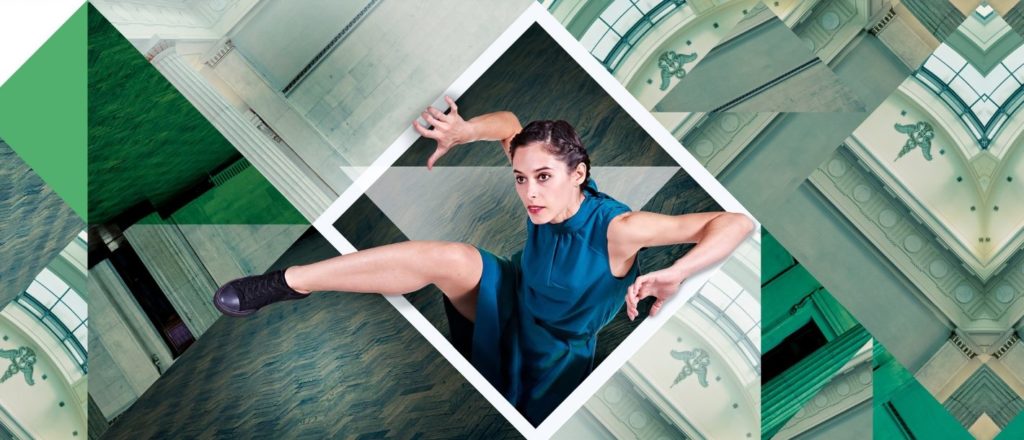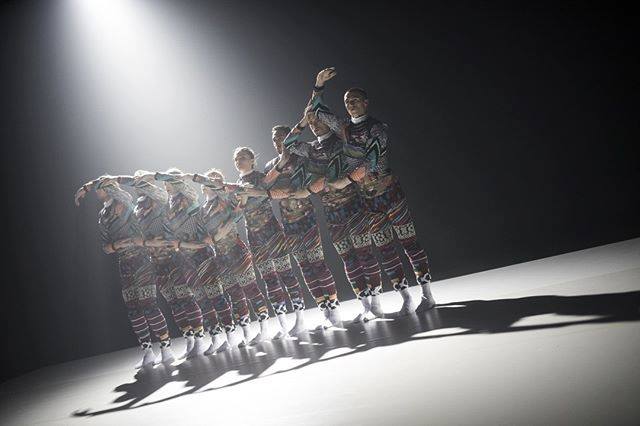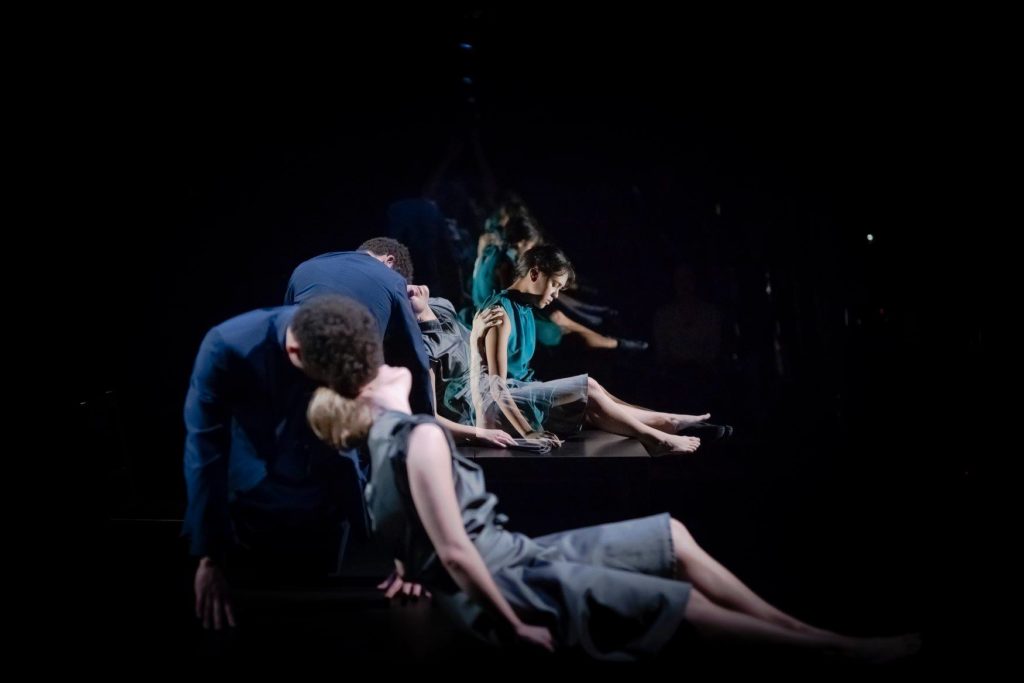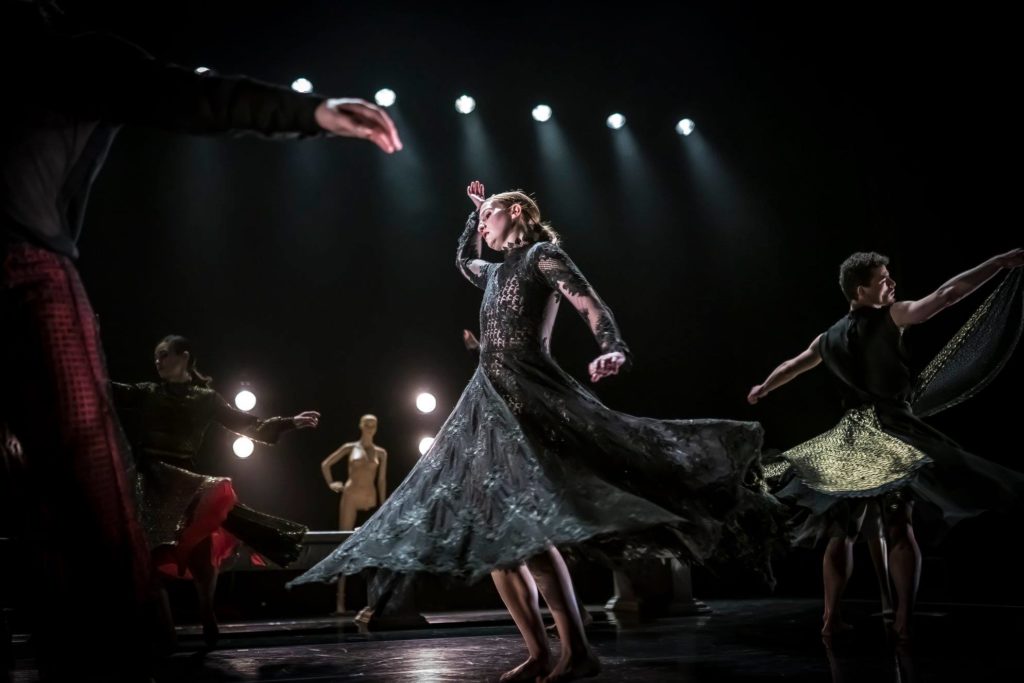
Taliesin Arts Centre has always felt welcoming to me. I particularly enjoyed collecting my tickets from the box office and having a smooch around the shop and gallery. Sadly the gallery is no longer there and a smart little box office has been established on the upper level. My ticket on this occasion, along with a very useful programme, is handed to me by a representative of the company and I am made very welcome.
Programmes are very important to me as I like to know a bit of background on the company and its creatives, and what I am about to encounter. The programme for Awakening is well written, with just enough information about everything I need to know. A summary of each piece and a brief description, with an extra word from the choreographer gives me just enough of an insight of what I am about to see without giving the game away. We are told that Awakening intends to ‘offer audiences diverse perspectives on the world’. The selection of 3 pieces shown tonight do that and more. It begins with Tundra, an entertaining and relatively accessible work, leads us into the very clever Afterimage and brings us finally to Reveller’s Mass, an unexpected and wild collage of religious iconography. A complimentary programme of work that does what an internationally acclaimed dance company should do – please, excite and challenge perceptions.
The audience is very mixed in age range, Taliesin Arts Centre and National Dance Company Wales have done well in their development of audiences for dance. I understand that Awakening has done well across its tour. Observing the marketing which includes stunning images and great trailers as well as the dedication to outreach work, I can see why it has been such a success. I expect that the company’s reputation and the quality of the work has meant that word of mouth, always the best form of advertising, has had a lot to do with it too.

The first performance of the evening, Tundra, is an excellent start to the evening. We are presented with a red square, with a dark and somewhat foreboding image of a tall dancer, making its first statement. We enter then a stage lit by 2 strip lights, the width of the stage, which whilst stark in appearance often alter in their brightness. The company of 7 dancers appear like Russian dolls, with patterned tops and long a-line skirts performing what I understand to be the traditional Beryozka dance, which just looks amazing; the dancers are so clever at this illusion of floating I wonder whether they are wearing Heelys to glide around the stage. The soundscape and subtle lighting design play their part here and throughout the piece; I feel as if I am looking into a time tunnel, a sort of digitally remastered version of these folk dancers, chained together and stuck in a time warp. Echoes of Russian folk music, throat singing and sounds of natural elements help to give a feel of otherworldliness captured in time.
Divested of their skirts, the dancers are now fully adorned in fabulously patterned body suits, reflecting the gaiety of folk costumes and with more contemporary colours, particularly the striking ice blue. With white socks they look at once like ice skaters and then like gymnasts; their precise, linked movements, performed in almost perfect unison, along with the lighting continue to make them appear Tron-like, as if they are trapped together in a computer memory. This is the thing I like best about contemporary dance, that it can be interpreted by the viewer in whatever way we want. Whilst the programme gives minimal instructions, there is plenty of room for my imagination to take me on that journey.
The choreography of Tundra is joyful, with so much to draw on, even including head bobbling, taking the reach of the Russian state into Asian territory. The soundscape continues throughout from thunderous crashes to the echoing sound of a child singing. The choreography relies on patterns and format; there are imperfections with a foot placed differently and a kick not quite in line, but I am tending towards intentional imperfection here, almost like a glitch in the system. The focus moves from marching upright to legs and feet, where once again the costumes come into play. I always marvel at dancers’ feet and these white sock clad movements continue the fascination. I am not surprised that this is such a popular piece.

Afterimage – the mirror that constantly reveals – is mesmerising in a totally different way. Initially I believe the set is 2 tables, 1 behind the other with 1 male sat at each. An illusion, as the whole work is an illusion set to confuse and play with our visual perception. A letter is delivered to the rear table using the method of Pepper’s Ghost, described in the programme as an effect originally used in carnival sideshows to conjure ‘ghosts’ in séances. The piece continues with reality and ghosts intertwined; 6 dancers, male and female, perform effortless movement and develop relationships that engage the viewer as their eyes adjust to see the dancer, the reflection and the ghost in a mirror that is so clear it feels like you could reach through it. It is strangely enticing to see the opposite view of the dancers as they move in and out of vision. The story of the piece is based around the letter, eventually opened and read, leaving the viewer with questions as to its content. Did she die? She looks like she died. Did she leave? It feels quite sad. Whatever the story, the effect of the female dancer walking away with one of the tables is a powerful ending to a piece that provides mysterious fascination to its end. Altogether a technically clever piece, although I fear that once viewed, the spectacle is gone.

Revellers’ Mass is everything it promises to be. As featured in the programme we are presented with a long thin table, its width almost covers the stage. This is the centre-piece, the table of the last supper, which eventually reveals that it holds the water and the wine as the dancers splash in it and perform on it. Candles placed along the ‘table’ are lit as church bells ring; an atmosphere of calm is created as people mill around. Strange looking broken mannequins with arms or bits missing, reminiscent of Da Vinci statues, complete the set. The costumes of black lace dresses worn by male and female in almost androgynous fashion look Italian or Spanish. A piano plays in the background, and then music – loud, dramatic, vocal, operatic enters the fray and the dance begins. It is a bizarre display, at times pious and at its most dramatic, irreligious. I don’t try to understand at this point, just to observe and enjoy, because the audience is silent and rapt in this feast of extraordinary choreography. It is as if we can see the Sodom and Gomorrah of the world behind the religious iconography. Dutiful gestures are mixed with what appear to be acts of disobedience; the choreography is untamed and appears to reflect different cultures and beliefs. The mannequins are brought into play, one carried around as if it symbolises a religious statue. A scene of wildness is created, with a central figure carrying a broken mannequin that pours gold onto the stage and is followed by an almost crawling figure that hankers after it as it spills from its guts. A false finish then, which on reflection feels intentional, as the movement stops, the lights lower and the audience begins its applause, which lasts for some time until we realise that there is more. The priest-like figure comes to the front of the stage and stands staring, whilst to the sounds of Piaf’s ‘Je ne Regret Rien’, the stage is cleared of its detritus by the rest of the cast. When we are sure that this is the end, the audience applauds loudly, showing their appreciation of this fantastic piece, which reflects the mess of the world in which we live.
A fabulous evening of dance, beautifully crafted, carefully performed and very well received.
Awakening is currently on tour and can be see at Aberystwyth Arts Centre 24th April, Sherman Theatre 1 and 2 May and Theatre Severn 7 May.
